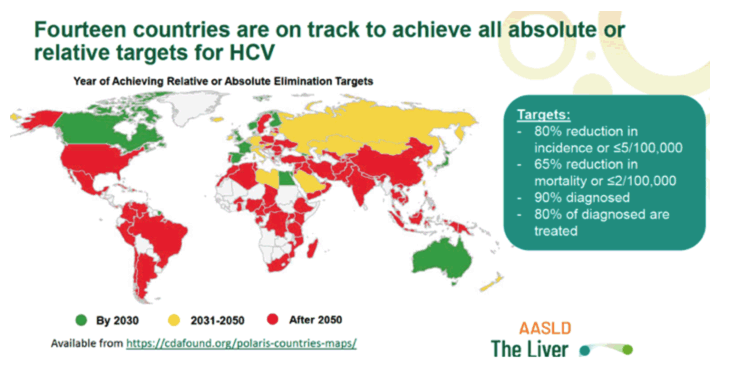| |
Global- Only 2% & 13% of HCV & HBV Infections Treated
|
| |
| |
Download the PDF here
AASLD 2022: Not On Track for Elimination - Updated evaluation of global progress towards HBV and
HCV elimination, preliminary data through 2021 (not good)

Only 2% of HBV and 13% of HCV infections have been treated.
3 million new infections and more than 1 million deaths are still caused by HBV and HCV each year.
New estimates showed that 1ۡ million people died from viral hepatitis in 2019, which was unacceptably high. This Article provides the first evidence of a global decline in HCV mortality, attributed to highly effective antiviral drugs and universal screening and treatment policies implemented in countries like Egypt. The continued scale up of treatment for HCV infection is crucial to reduce the HCV mortality.12 Furthermore, countries need to strengthen their mortality data by using death registry or national cancer registry data.
Globally, 90% of HBV infections remain undiagnosed and 98% of HBV infections have not been treated. By contrast, 79% of HCV infections remain undiagnosed, and 87% of HCV infections have not been treated. Treatment for HBV is progressing much too slowly, despite affordable treatments, as is HCV prevention and harm reduction among people who inject drugs. Most viral hepatitis infections are not diagnosed or treated. Price reductions have made HCV treatment an affordable, highly effective intervention, but the 13% coverage needs to increase another five and a half times in the next decade to reach the 2030 target (72%) for elimination ,15 which will require a huge scale up and simplification of diagnosis and treatment.12
An accelerated global strategy to improve treatment coverage is needed, which requires national action plans and financial support. All countries should develop tailored policies to improve treatment coverage, develop guidelines, and improve surveillance, to measure progress and better highlight gaps in data quality or completeness.12 Low-income and middle-income countries still cannot afford the cost of drugs for elimination of viral hepatitis, so access to generic drugs is needed.18 Countries should invest in the treatment of viral hepatitis to prevent future deaths, and as a cost-saving investment.19, 20
The COVID-19 pandemic has negatively affected access to screening and treatment for viral hepatitis, owing to mobility restriction rules, inadequate access to health facilities, and other disruptions, so all stakeholders should explore new models of care that address such barrier to access. Telemedicine and self-testing could help maintain treatment provision.18, 21The decentralisation of care and its integration into primary health-care support has improved access to testing and linkages to care and treatment, and such strategies could expand service accessibility and improve equity and efficacy in health care.22
Global reporting of progress towards elimination of hepatitis B and hepatitis C
Fuqiang Cui, Sarah Blach, Casimir Manzengo Mingiedi, Monica Alonso Gonzalez, Ahmed Sabry Alaama, Antons Mozalevskis, Nicole Séguy,
Bharat Bhushan Rewari, Po-Lin Chan, Linh-vi Le, Meg Doherty, Niklas Luhmann, Philippa Easterbrook, Mae Dirac, Catherine de Martel,
Shevanthi Nayagam, Timothy B Hallett, Peter Vickerman, Homie Razavi, Olufunmiayo Lesi, Daniel Low-beer
Summary
Background
The 69th World Health Assembly endorsed the global health sector strategy on viral hepatitis to eliminate viral hepatitis as a public health threat by 2030. Achieving and measuring the 2030 targets requires a substantial increase in the capacity to test and treat viral hepatitis infections and a mechanism to monitor the progress of hepatitis elimination. This study aimed to identify the gaps in data availability or quality and create a new mechanism to monitor the progress of hepatitis elimination.
Methods
In 2020, using a questionnaire, we collected empirical, systematic, modelled, or surveyed data-reported by WHO country and WHO regional offices-on indicators of progress towards elimination of viral hepatitis, including burden of infection, incidence, mortality, and the cascade of care, and validated these data.
Findings
WHO received officially validated country-provided data from 130 countries or territories, and used partner-provided data for 70 countries or territories.
We estimated that in 2019, globally, 295۩ million (3ۨ%) people were living with chronic hepatitis B virus (HBV) infection and 57ۨ million (0ۨ%) people were living with chronic hepatitis C virus (HCV) infection.
Globally, there were more than 3۠ million new infections with HBV and HCV and more than 1ۡ million deaths due to the viruses in 2019.
In 2019, 30ۤ million (95% CI 24ۣ–38۠) individuals living with hepatitis B knew their infection status and 6ۦ million (5ۣ–8ۣ) people diagnosed with hepatitis B received treatment.
Among people with HCV infection, 15ۢ million (95% CI 12ۡ–19۠) had been diagnosed between 2015 and 2019, and 9ۤ million (7ۥ–11ۧ) people diagnosed with hepatitis C infection were treatedwith direct-acting antiviral drugs between 2015 and 2019.
Interpretation
There has been notable global progress towards hepatitis elimination. In 2019, 30ۤ million (10ۣ%) people living with hepatitis B knew their infection status, which was slightly higher than in 2015 (22۠ million; 9۠%), and 6ۦ million (22ۧ%) of those diagnosed with hepatitis B received treatment, compared with 1ۧ million (8۠%) in 2015. Mortality from hepatitis C has declined since 2019, driven by an increase in HCV treatment ten times that of the strategy baseline. However, an estimated 89ۧ% of HBV infections and 78ۦ% of HCV infections remain undiagnosed. A new global strategy for 2022–30, based on these new estimates, should be implemented urgently to scale up the screening and treatment of viral hepatitis.
| |
| |
| |
|
|
|